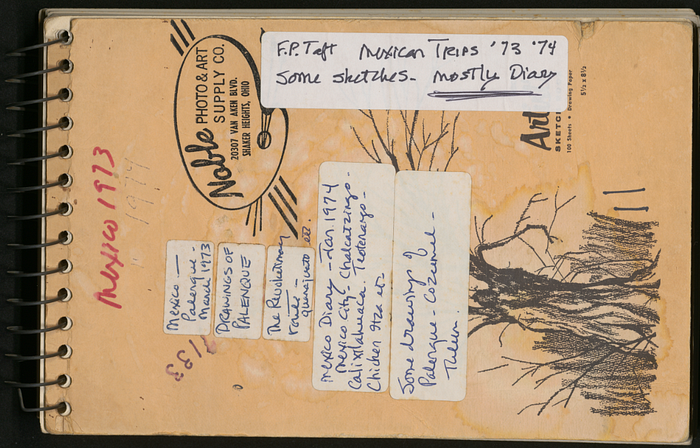Traveling through the Archives: Digitizing the Travel Sketchbooks of Frances Prindle Taft
- Blog Post
- Ingalls Library and Museum Archives

As a digitization intern at the Ingalls Library and Museum Archives this summer, I’ve had the great fortune to work with several different objects, ranging from rare folios that have just recently entered the public domain to archival materials from the Frances Prindle Taft Collection.
Frances Prindle Taft (1921–2017) was an art historian with deep ties to the Cleveland area and the CMA. She graduated from Vassar College in 1942, where she majored in zoology and minored in art history. Later that year she joined the US Navy as part of the Women Accepted for Volunteer Emergency Services (WAVES) program during World War II. In 1943 she married Seth Chase Taft, grandson of President William Howard Taft. They had four children. She taught art history at the Cleveland Institute of Art from 1950 to 2012. She was a member of the CMA’s Junior Council (which later became the Womens Council) and the board of trustees. One of her major research focuses was pre-Columbian art. She traveled extensively, taking 19 trips to Mesoamerica, as well as many other places throughout her life. She documented these travels in journals, taking detailed notes and sketching various locations she visited, often in gorgeous watercolor illustrations.

During my internship, I’ve been digitizing a small selection of Taft’s journals. Some of these document trips to Mexico (fig. 1). The sites she visited and the notes and sketches she made demonstrate her commitment to studying pre-Columbian art. While in Mexico, she often visited archaeological sites and ruins, many of which she drew and wrote about in these journals. She also recorded elements of her travels such as the landscapes and food she enjoyed (or did not enjoy), local culture and people, agriculture, and transportation.
Included in her journals are also domestic trips with Seth and their children, as well as trips to Europe during which she visited France, Italy, Spain, Greece, Switzerland, and Malta (fig. 2). Her drawings illustrate the landscapes and architecture that she admired, and her journal entries give details about many elements of her trips — prominent among them are her notes on art and architecture.
A notable feature of Taft’s travel sketchbooks is the editing throughout. Many pages contain what can be assumed are later additions to the text — clarification of words and phrases — in the same (though neater) handwriting originally used. These marks are typically in a different pen color and stand out on the page, leaving spots of color through the journals (even beyond the watercolor drawings and colorful pens she sometimes used for the main content).

The covers of the journals also frequently include detailed notes on their contents. The journal about her 1973 and 1974 trips to Mexico, for example, has six label stickers on its cover (fig. 3). These labels include details about locations the journal documents and some of the sketches it contains. From this scrupulous documentation and editing, it’s clear that Taft wanted her journals to be readable in the future — certainly, it seems, as a reference or memento for herself. These clarifications also lend more clear readability to her travel notes for those viewing them today.

Digitizing Taft’s journals increases their accessibility — now that they’re online, anyone from researchers to Taft’s family can view them without needing to be in the Ingalls Library. As I’ve worked on projects this summer, I’ve seen just how important it is to make materials available digitally. Taft’s journals can be viewed in the Cleveland Museum of Art Archives Digital Collections, once again able to travel the world, as people from all over have the opportunity to view them.